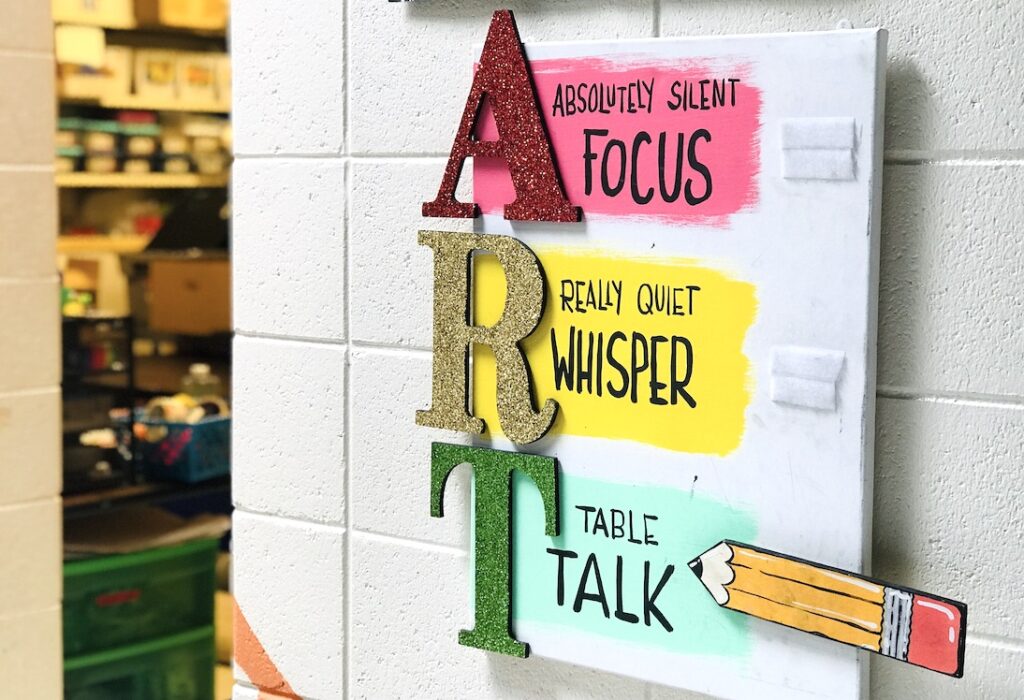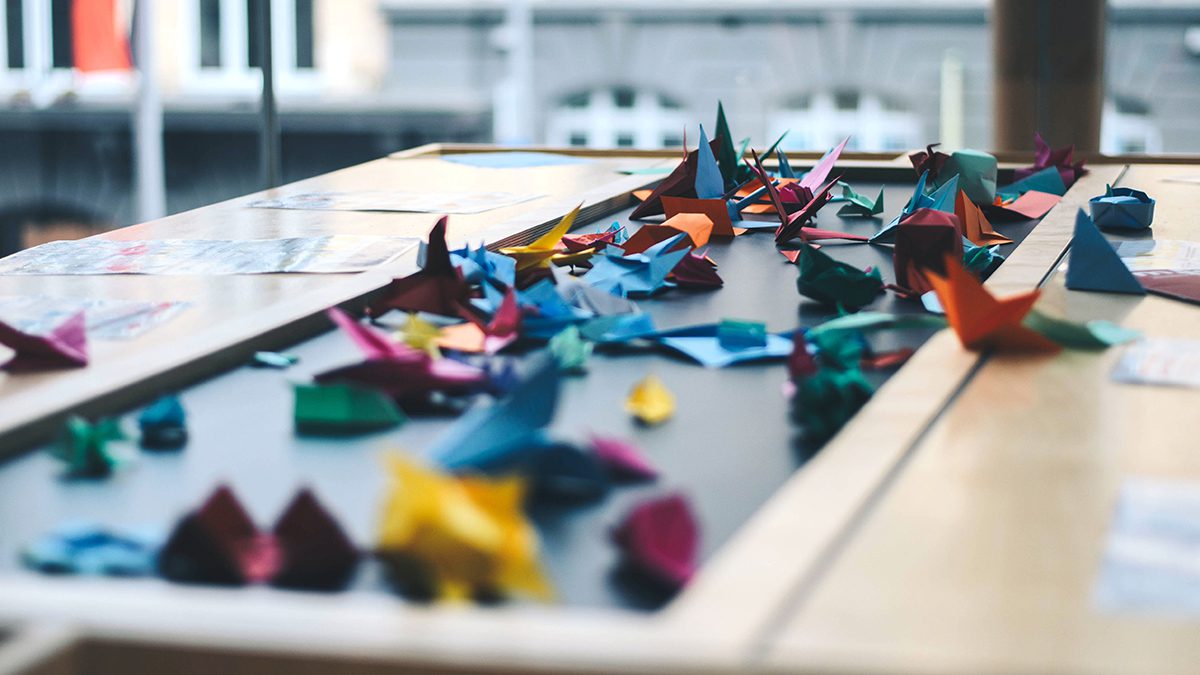Self-care for educators is a topic that has been written about extensively. There’s everything from professional development to online articles to entire Facebook groups about it. Teachers should have self-care down, right? But any teacher would probably tell you that that is not the case. After this past year and a half, we have seen historically low teacher retention. Many educators are citing their main reason for leaving as stress and poor mental health, even before the COVID-19 pandemic.
Our job as art teachers has always been different than our general or core content classroom colleagues. We tread a fine line between providing a safe place for students to challenge themselves creatively while also justifying the existence and funding of our programs. Elementary art teachers see more students per day than any elementary classroom teacher. Since we are different, how we care for ourselves has to be different too. Many teachers already have their own self-care practices at home and outside of the classroom. However, teachers must develop self-care practices during class time as well.
Read on for three easy ways to prioritize yourself during the school day.

1. Maintain noise levels to reduce anxiety.
One of the best parts of teaching art is the absolute joy students experience in a bustling art room. Often, art class is the one part of the day where students can let loose and express themselves. However, sometimes students can get a little too excited, and as a result, the noise level in the room skyrockets. It’s easy to become overstimulated by noise, which can trigger feelings of anxiety and even panic. Chances are, if you are feeling overwhelmed by the noise, some students are too.
If you find your classroom is often louder than you would like, but you don’t want to limit student excitement, consider introducing a noise level chart. Have a few levels, ranging from complete silence to full conversation. You can check out Cassie Stephens’ tips here and Sarah Krajewski’s acronym chart here. There are even interactive app-based monitors. When you introduce this new tool to your students, do so thoughtfully. You can even make the introduction a game. Quickly switch back and forth between levels so students can practice what each noise level means. By keeping the introduction playful and engaging, students will have it down in no time. Setting this norm protects you from overstimulation while still providing a safe and fun working environment for your student artists.

2. Set boundaries to minimize interruptions.
Students are always excited to tell you about their life outside of your classroom. But maybe you just returned from your third IEP meeting this week. Or maybe the grading deadline is coming up, and four students turned in a bunch of late work. Or perhaps the kiln needs to be loaded and fired so everything will be ready in time for the end-of-the-year show. While student interruptions are sweet, they can throw you off your groove. If you try to hold these personal conversations while distracted, students sense you are not invested in what they are sharing with you. Plus, according to The Greater Good publication from UC Berkeley, interruptions to tasks can make you “irritable, anxious, and unproductive.”

Prevent distraction and irritability by setting up a way for students to know when you are available for non-academic conversation. You could use a visual indicator that you are available for chatting, like an Open/Closed sign. You could have students write their names on the board if they need more than a moment or two. Erase each name following the conversation. Because you control when you have these conversations, you can fit them in when it works best for you. Students will understand that they may have to wait a few minutes for you to complete a task, but they know they will have your undivided attention when it is their turn. They also appreciate the visual of the list because they can anticipate when they will be able to meet with you. Your students also learn to self-regulate and prioritize what they share with you.
For more tips on setting boundaries, check out this article.
3. Make art with your students to prioritize your creativity.
One of the best parts of our job is that we get to make art. It’s important to make time during the school day to scratch your creative itch. Sit with your students and make art with them. This could be your own personal work or you could work on the same project that they are working on. In doing so, you can focus on your craft as both artist and teacher. Creating art during class prioritizes your students as well. you model strong studio habits, how to be respectful of artmaking tools, and how to handle times when things don’t turn out quite right. Watching you make mistakes or refine your work gives students permission to do the same. It also shows students that you practice what you preach. They really do enjoy seeing their teachers make things!
Making art with your students fosters a true studio setting. It allows for a more organic connection with the students. If you are sitting with them, you are there for more candid conversations that build positive relationships. If they have a question, they will find you. You will discover that your art room will likely become quieter and more focused. Students respect and understand that you are working on your creative problem-solving skills as well.
It also builds artmaking into your day. Being an artist is in your blood, but artmaking may have been thrown to the wayside in lieu of other teaching responsibilities. As you prioritize working alongside your students, you prioritize your own creativity.

Tools like seeing a therapist regularly and making your own artwork at home are important parts of self-care. But it’s vital that we also care for ourselves at work too. We know the importance of social-emotional learning and the effects stress has on our students. Why not include ourselves as well? Putting yourself and your own self-care first during instructional time does not compromise instructional quality. We challenge you to take some time to reflect on what you need during the school day and then put it into place. When teachers feel better, their students do too.
This article may have inspired you to look at your curriculum through a more therapeutic lens or to look into art therapy techniques for your classroom. If so, we have some resources to get you started:
- You can learn how to apply a therapeutic lens to your instruction with our two PRO Packs, Art Therapy Basics and Bringing Art Therapy Techniques Into Your Practice, hosted by board-certified art therapist Caroline Tye.
- If you want some art lessons that incorporate mindfulness, look no further! Take a look at the FLEX Collection, Inspired by Mindfulness.
- If you want to get even deeper into art therapy strategies, check out the course, Art Therapy for Art Teachers. Here is an Art Ed Radio episode that talks more about the course.
What is one way you prioritize yourself during the school day?
How do students know when they can chat with you?
What is a benefit that comes from artmaking with your students?
Magazine articles and podcasts are opinions of professional education contributors and do not necessarily represent the position of the Art of Education University (AOEU) or its academic offerings. Contributors use terms in the way they are most often talked about in the scope of their educational experiences.





